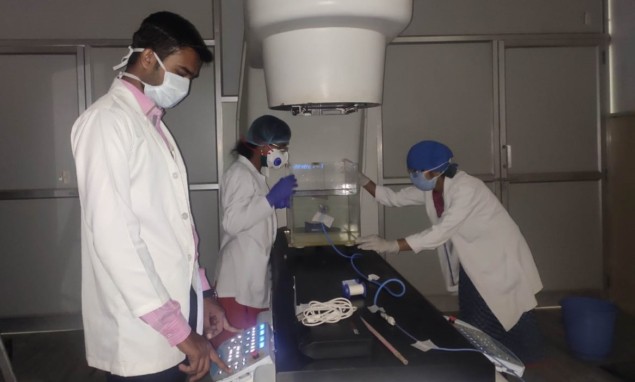Priya Saini is a medical physicist in the radiological physics department of SMS Medical College and Hospitals in Jaipur, India.
This post is part of a series on how the COVID-19 pandemic is affecting the personal and professional lives of physicists around the world. If you’d like to share your own perspective, please contact us at pwld@ioppublishing.org.

India reported its first case of COVID-19 infection on 30 January 2020, and currently has the largest number of confirmed cases in Asia. The first case in the state of Rajasthan was in Jaipur, reported on 3 March. Since then, the SMS Medical College and Hospitals in Jaipur has served as the main COVID-19 treatment centre in Rajasthan. The hospital established a fully equipped outpatient department and isolation wards, as well as procuring a number of new X-ray machines and mobile X-ray units for diagnosis and treatment evaluation of COVID-19 patients.
As part of this transition, with the exception of the radiation delivery facility and a small intensive care unit for cancer patients, all other radiotherapy and radiological physics facilities were utilized for COVID-19 patient management. When lockdown was initiated end-March, there were four medical physicists in the hospital (two of whom were in vulnerable groups). Having handed over department space for COVID-19 management, they had to evolve rapidly to cope with the ensuing professional and personal challenges.
The hospital’s radiological physics department, which provides medical physics services to all departments that utilize ionizing radiation, took the lead role in managing cancer patients. As well as maintaining equipment and infrastructure, the team needed to rearrange radiation physics equipment and facilities to ensure patient services continued unhindered. Challenges included establishing protocols for radiography and radiotherapy delivery, maintaining the quality of diagnostic and treatment systems, achieving high patient throughput in the minimum time possible and managing the workload with a reduced workforce.
Priya Saini is a medical physicist in the hospital’s radiological physics department. Here is her account of maintaining a radiotherapy service in the midst of a pandemic.
Optimizing efficiency
During lockdown, I worked on cobalt teletherapy (on the Bhabhatron-II system) and brachytherapy. My work included treatment planning, radiation safety monitoring, quality assurance (QA), routine equipment calibration and treatment plan reviews, as well as teaching and research.
In early March, at the start of the pandemic, COVID-19 isolation wards were created in one or two departments in our hospital. As the number of patients increased, our cancer wards and other departments’ wards were also converted into isolation wards. Our physics and dosimetry facilities were vacated for doctors and nurses treating COVID-19 patients. At that time, only one room was left for us to conduct our routine work.
In this early phase of the COVID-19 pandemic, I had many difficulties in managing patients because of lack of awareness and fear of this virus. Then I spent extra time reading the available information and followed the guidelines given by WHO, and slowly I overcame my fear.
In our department, we used to treat 100 to 120 patients each day on the Bhabhatron-II telecobalt machine. This number quickly halved, because it became harder for patients to travel to the hospital and some had already returned to their hometowns or villages. However, some patients recommended for surgery were transferred to radiation therapy, so workload in our department slowly increased.
For certain cases, including some patients with early-stage cancer, we delivered radiation therapy over a shorter period of time. The main reason for such hypofractionated treatments was to minimize viral exposure and the risk of contaminating patients, without reducing the effectiveness of the treatments. Our aim was to establish a better way to treat all patients who can benefit from radiotherapy; and not to delay the start of treatment of any patient whose deferral may worsen the prognosis of their disease.
After lockdown, as the necessity of providing regular medical services to the general public became essential, our hospital resumed normal activity by shifting the COVID-19 patients to the university hospital and radiation treatments continued normally again. Every day, healthcare workers screened patients with thermal scanning before registering them for treatment and providing them with hand sanitizer.
To help avoid cross contamination, I made a separate box in the manual treatment planning room for each patient to store their treatment documents. I also instructed the security guard to send only one patient at a time into the room, with every patient advised to maintain physical distancing of one metre minimum. Before starting treatment, every patient was verified to be COVID-19 negative.
At the brachytherapy treatment console, three people were present at the time of treatment: one technologist, one resident doctor and myself. We maintained physical distancing from each other. We did not allow patients or their companions to enter the treatment planning room or console and instead interacted with them while maintaining a one metre distance outside the minor operating theatre.
Additional challenges
Personal protective equipment (PPE) has become an emotive subject during the current COVID-19 epidemic, as an important component, though only one part, of a system to protect staff and patients from cross-infection. During the lockdown period, however, the temperature in Jaipur reached up to 46°C. As per guidelines at that time, we were not using centralized air conditioning, to prevent the spread of virus via air circulation. So it was very difficult, as well as unhealthy, for us to wear PPE kit while treating the patients.
In cases of intraluminal brachytherapy, there was direct interaction with patient while taking the measurements for planning. During such instances I wore PPE kit. After treatment completion, the PPE kits were discarded properly and I washed my hands and face with soap.
To increase awareness of COVID-19 to the patients and others, we pasted notices in the treatment planning room, the calculation room and on other rooms’ doors, with messages in local languages: “no entry without a mask”, “maintain social distancing” and “do not enter without permission”. We asked all ongoing patients about symptoms and other health-related issues; if found symptomatic, patients were sent for COVID-19 tests.
My other roles included QA of the machines in the department and teaching. We performed mechanical QA of both treatment machines weekly and performed dosimetry QA monthly. Before starting, we would sanitize the treatment room and control console to prevent contamination and spread of the virus.
During this period, a few resident doctors in my department became COVID-19 positive. I had interacted with one of them two days earlier, which made me scared. I did self-assessments for 3–4 days and also consulted with a general physician. Following that, two technologists posted on the Bhabhatron-II machine tested positive for COVID-19. Following institutional protocol, they were home quarantined for 14 days. After quarantine, they tested negative and re-joined the hospital.

Physics in the pandemic: ‘Our event had grown from a hub for the UK to a truly global event within a matter of days’
As per local government instructions, undergraduate paramedical students were taught via online Zoom classes during lockdown. There are five postgraduate students and, after lockdown, they re-joined regular classes. I conducted many classes for students of radiotherapy technology and radiology technology, maintaining proper distance in a department seminar room. I also instructed them regarding hospital protocols, the necessity of proper hygiene, and not to sit together without masks and maintaining social distancing.
Recently, one of the students got severe symptoms similar to COVID. He was asked to take a COVID-19 test and not to return until he had a negative result, while the other four students were asked to self-quarantine. After 24 hours, he tested negative and rested for a few days to recover from weakness.
The COVID-19 pandemic has affected everyone globally, and our department of radiological physics is no exception. We are striving to keep ourselves and our near and dear safe, while continuing to provide medical physics services to all radiological facilities of our institute, without compromising international standards.



